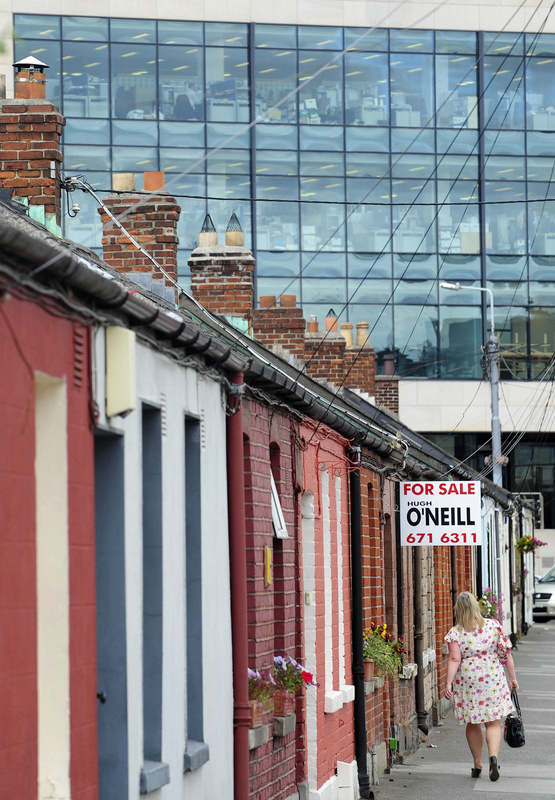DUBLIN — In Dublin, the epicenter of Western Europe’s worst housing-market crash, signs of life are emerging for those with access to cash.
A five-bedroom, Victorian-era home near the center of Dublin was sold last month for 2.05 million euros ($2.6 million), 17 percent more than the reserve price. At the other end of the market, apartments are being snapped up at auction for as little as 50,000 euros ($63,580) in cash. Even prices for homes requiring mortgages across the country rose for a third straight month in September, the Central Statistics Office said.
“It’s the first time I’ve bought in Ireland,” said Neil Cotter, 47, an accountant based in Gibraltar who last month bought three Dublin apartments at a sale of distressed real estate. “I just had a look at all the markets in Europe and it seemed the most attractive.”
Since the end of the Celtic Tiger boom that made Ireland the fastest-growing economy in the euro region in the decade ending in 2007, property prices have fallen by 50 percent, ruining the country’s banks and forcing the government to follow Greece and seek an international bailout. While bankers and analysts are split on calling the bottom, they agree any further recovery depends on a revival in mortgage lending, which the Irish Banking Federation says dropped 95 percent from the peak.
“I’m not calling any massive recovery, but people are going to look back and see a lot of missed opportunities in Ireland if they had the cash,” said Keith Lowe, CEO of Dublin-based property broker Douglas Newman Good. “Banks must understand that in order to have a proper recovery, they must lend.”
IRISH TURNAROUND IN SIGHT?
Mortgage lending in the first half of this year dropped to 950 million euros ($1.2 billion) from 18.5 billion euros ($23.5 billion) in the same period in 2006, the Irish Banking Federation said. Cash now accounts for half of all sales as banks balk at taking on more mortgage debt, Goodbody Stockbrokers in Dublin estimates.
Cotter said he paid 100,000 euros to 200,000 euros ($127,000 to $254,000) for each of the one- and two-bedroom apartments at the auction and is renting them out. He expects a yield, or rental income as a proportion of capital value, of 10 percent in Dublin.
Property prices in the city rose 2.6 percent in September.
“It’s for my pension frankly,” Cotter said Oct. 9, following the sale. “I’ve been holding off on investing in property for five or six years, and Ireland went into that range that offered a very attractive proposition.”
There are cheaper properties available just outside the city center. A two-bedroom apartment in a west Dublin suburb was sold last month by auctioneer Allsop Space for 50,000 euros, or $63,580.
Irish home prices quadrupled in the decade through 2006. Building surged, helping to transform Ireland into the fastest-growing economy in the euro region. The boom ground to a halt in 2008, in the wake of Lehman Brothers Holdings’ collapse and the subsequent credit drought.
In Dublin, house prices are down 55 percent from their peak in 2007, while apartment prices have fallen 63 percent, the country’s central statistics office said last month. Outside the capital, prices are down 46 percent.
Now, a turn may be in sight. Last month, prices across the country climbed 0.9 percent, accelerating from 0.5 percent in August and 0.2 percent in July, according to the central statistics office. Bank of Ireland Plc saw “a noted pickup” in mortgage demand in September and October, Chief Executive Officer Richie Boucher told lawmakers Nov. 1. The bank, Ireland’s largest by assets, accounts for 40 percent of new mortgage loans.
“We genuinely believe the housing market may have turned around after bottoming in June,” Owen Callan and Frank Oeland Hansen, analysts at Danske Bank, a primary dealer in Irish government debt, said in an Oct. 26 note. “Potential home buyers might begin to view this as a golden opportunity.”
CREDIT REQUIREMENTS STILL TIGHT
A mix of reasons may lie behind the signs of recovery.
The supply of family homes is limited in some parts of Dublin after the building boom ended. About 10,000 homes were completed last year, down from about 93,000 in 2006, based on government figures.
Unemployment, which tripled to 14.8 percent between 2007 and 2011, stopped rising this year. Also, the government plans to phase out a tax break for first-time buyers at the end of the year, encouraging some people to buy now.
While Danske Bank says prices have fallen by as much as 15 percent beyond where they should be, many analysts question whether recent increases are sustainable. Alan Dukes, chairman of the former Anglo Irish Bank Corp., told lawmakers in Dublin on Oct. 31 that prices may fall further.
“I would not be confident in saying that we have reached the bottom of the property market,” Dukes said, adding he’s skeptical about reports suggesting prices may continue to rise. “I wonder if they are talking up the market in order to generate a bit more money.”
Access to money is still the main barrier to a lasting improvement in the market. Irish banks tightened credit requirements on home loans even as demand increased in the third quarter, the nation’s central bank said Oct. 31.
At the market’s peak, banks were offering mortgages of 100 percent of the value of a property. These days, it’s more likely to be 80 percent, according to Karl Deeter, compliance manager with Dublin-based Irish Mortgage Brokers. Banks are also making more deductions to disposable income, such as 200 euros to 250 euros ($296 to $318) for every child in a family, he said.
“It’s now nearly impossible for families with a few children and living off one income to get a mortgage, unless the person who is working is earning more than 100,000 euros,” or $127,000, Deeter said in an interview.
Irish banks may be conserving capital as mortgages arrears mount. While they have set aside about $8.1 billion of provisions for expected bad loans, actual write-offs over the 30 months to June were $317 million, Goodbody Stockbrokers said.
A THIRD OF HOME LOANS IN ARREARS
The extra yield investors demand to hold Irish mortgage bonds is 5.35 percentage points above benchmarks, according to JPMorgan Chase & Co. While that’s down from a spread of 9.5 percentage points in July, it’s more than seven times that of similar top-ranked bonds tied to British mortgages.
About 30 percent of Irish home loans by value, including buy-to-let mortgages, are in arrears or have been modified. The government is urging banks to forgive some unsustainable mortgage debt.
Ireland needs “to see solutions that involve much more dramatic write-off of debt in respect of households that are really in nonsustainable situations and have an inability to pay,” John Moran, the most senior official in the Finance Ministry said, in a speech Oct.16.
For their part, the lenders say home loans aren’t the lucrative business they once were. Allied Irish Banks, the country’s largest mortgage lender, is making home loans at a loss, Fergus Murphy, head of products at the Dublin-based bank, told lawmakers Oct. 31.
“The process is clearly loss-making,” Murphy told a parliamentary committee. “We’ll have to sell products at AIB at a profit going forward, the same as any viable bank would.”
– With assistance from Joe Brennan and Finbarr Flynn in Dublin and Esteban Duarte in Madrid.
Send questions/comments to the editors.




Success. Please wait for the page to reload. If the page does not reload within 5 seconds, please refresh the page.
Enter your email and password to access comments.
Hi, to comment on stories you must . This profile is in addition to your subscription and website login.
Already have a commenting profile? .
Invalid username/password.
Please check your email to confirm and complete your registration.
Only subscribers are eligible to post comments. Please subscribe or login first for digital access. Here’s why.
Use the form below to reset your password. When you've submitted your account email, we will send an email with a reset code.